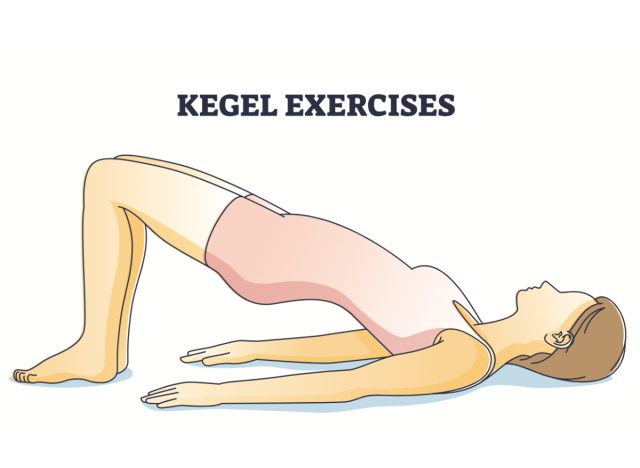Showing your pelvic floor muscles TLC should be a key part of your fitness and wellness routine—that includes working them out! If you didn’t already have the best exercises for a strong pelvic floor on your radar, you certainly should, and we have you covered.
Your pelvic floor is a group of muscles situated at the bottom of your pelvis. When your pelvic floor muscles contract, they hold up your pelvic organs; help you hold in urine, stool, and any gas; and secure your pelvic joints. When you relax these muscles, you’re able to go to the bathroom, comfortably insert a tampon, or even give birth. If your pelvic floor muscles are weakened, you may experience bowel or bladder issues and discomfort such as constipation, the urgency to pee, leaking stool or urine, and pelvic pain when exercising.
Building up the strength of these muscles is not a question—it’s a necessity. We spoke with the experts who share what causes a weak pelvic floor, along with some of the best exercises you can do in order to strengthen it.
What causes weak pelvic floor muscles?


Celestine Compton, PT, DPT, physical therapist and clinical content lead, tells Eat This, Not That!, “Muscle weakness in any part of the body typically stems from dysfunction, disuse, or injury. In the case of pelvic floor muscles, dysfunction can stem from a number of factors including obesity, experiencing a large volume of strenuous activity during the teenage years, participation in high-impact exercise or sport, or a history of reproductive, gastrointestinal, or urinary system issues like endometriosis, IBS or chronic UTIs.”
You can injure your pelvic floor muscles during pregnancy, while giving birth, or even due to an injured pelvis, tailbone, or hip bone. A sedentary lifestyle, weight gain, and menopause could also result in a weakened pelvic floor. If you notice any changes in your bladder or bowel, it’s crucial to speak with a healthcare professional as soon as possible to pinpoint what’s going on and the proper tools you need to get better.
Why is it important to perform pelvic floor exercises?
When it comes to exercising your pelvic floor muscles, Dr. Barbara Frank, Harvard-affiliated OB/GYN and Attn: Grace medical advisor, explains, “One problem is people keep their pelvic floor tense all of the time and that is a recipe for disaster and pain,” she explains. “If they don’t relax and loosen, you can’t pee or poop … Any exercises that also include holding in your core, strengthing the core are great for the pelvic floor.”
Dr. Frank says you should perform Kegels on a daily basis and core training a few times a week. When you feel like your symptoms have gotten better, then you can decrease Kegels to just a few times each week. It’s important to listen to your body.
What are the best exercises for a strong pelvic floor?


Roll out your exercise mat, get comfortable, and gear up for these expert-approved exercises for a strong pelvic floor.
READ RELATED: High Uric Acid: 5 Foods To Add In Your Diet To Lower Uric Acid Levels Naturally
1. Quick Flick Kegels
“This targets the fast twitch fibers of your pelvic floor that are responsible for holding in pee or gas with coughs, sneezes, or jumps,” Compton explains.
You’ll start by lying flat on your back. (Compton notes you can also perform this exercise while seated, kneeling, or standing as you improve coordination and build more confidence in performing this movement.) Next, bring your pelvic floor muscles up and inward; imagine attempting to stop yourself from peeing midstream. For two seconds, hold this “maximum strength contraction,” as Compton calls it. Then, quickly release. Rest for three to six seconds between reps so your muscles are able to completely relax.
2. Duration Hold Kegels
“This targets the slow twitch fibers of your pelvic floor that are responsible for supporting your pelvic organs and stabilizing your pelvis for extended periods of time,” Compton tells us.
Start this exercise by lying flat on your back. Bring your pelvic floor muscles upward and in the same way you did for the previous exercise. For a total of 10 seconds, hold this moderate to maximum strength contraction. Then, quickly release your pelvic floor muscles. Rest for three to six seconds between reps so your muscles are able to completely relax before doing the exercise again.
3. The Knack
According to Compton, “This targets your pelvic floor muscles’ ability to hold in pee or gas and effectively manage increased pressure in your abdomen as with coughing or lifting heavy weights.”
You’ll start once again by lying flat on your back. Bring your pelvic floor muscles upward and in. Hold this “maximum strength” contraction while you fake cough one to three times or make loud sounds as if you were coughing or sneezing. Then, release your pelvic floor muscles, and rest for three to six seconds.
4. Diaphragmatic Breathing


“This exercise helps to maintain your pelvic floor and core muscle resting tone, range of motion, and strength and is one of your many core stabilizers,” Compton explains.
Start your diaphragmatic breathing by lying flat on your back, sitting down, or standing. Put both hands below your ribs, on your stomach, or right above your public bone. Breathe in as air fills up your lungs and your abdomen expands into both hands. Every time you inhale, think of your pelvic floor “lengthening” as if it were the bottom of a balloon being inflated. Then, breathe out as your belly comes back toward your spine. Repeat this exercise.
5. Walking or Yoga
Last but not least, stretch it out with some yoga, or lace up your sneakers and head out for a walk. “Your pelvic floor needs to work in order to stabilize the joints of your pelvis,” Compton tells us. “The more regularly you can engage in exercises like walking or yoga, the more your pelvic floor is forced to activate in a functional way and for prolonged periods.” Engaging in these physical activities will establish lifelong habits that help your pelvic floor build up and preserve its endurance and strength.











